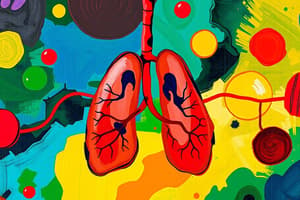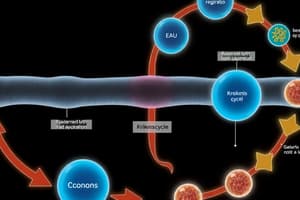Podcast
Questions and Answers
What is the primary role of NADH in cellular respiration?
What is the primary role of NADH in cellular respiration?
- To release carbon dioxide
- To carry electrons (correct)
- To serve as the final electron acceptor
- To produce glucose
Which process of cellular respiration occurs outside the mitochondria?
Which process of cellular respiration occurs outside the mitochondria?
- Citric Acid Cycle
- Electron Transport Chain
- Glycolysis (correct)
- Krebs Cycle
What is produced as a byproduct in the Krebs cycle?
What is produced as a byproduct in the Krebs cycle?
- Carbon Dioxide (correct)
- Oxygen
- Water
- ATP
Which of the following statements about the Electron Transport Chain is true?
Which of the following statements about the Electron Transport Chain is true?
Which molecule serves as the primary energy currency of the cell?
Which molecule serves as the primary energy currency of the cell?
Which of the following occurs during glycolysis?
Which of the following occurs during glycolysis?
What is the function of mitochondria in cellular respiration?
What is the function of mitochondria in cellular respiration?
What is the main role of oxygen in the Electron Transport Chain?
What is the main role of oxygen in the Electron Transport Chain?
Flashcards
Cellular Respiration
Cellular Respiration
A process that converts glucose into energy in the form of ATP
Glycolysis
Glycolysis
The first step of cellular respiration, breaking down glucose into pyruvate
Krebs Cycle
Krebs Cycle
The second step in cellular respiration, converting pyruvate to citric acid; releases CO2
Mitochondria
Mitochondria
Signup and view all the flashcards
ATP
ATP
Signup and view all the flashcards
Electron Transport Chain (ETC)
Electron Transport Chain (ETC)
Signup and view all the flashcards
Glucose
Glucose
Signup and view all the flashcards
Oxygen in Cellular Respiration
Oxygen in Cellular Respiration
Signup and view all the flashcards
Study Notes
Cellular Respiration
- Cellular respiration is the process by which organisms obtain energy (ATP) through the breakdown of glucose (C6H12O6)
- Glucose stores potential energy
- The process involves three main pathways: Glycolysis, Krebs Cycle, and the Electron Transport Chain (ETC)
Glycolysis
- Occurs in the cytoplasm
- Anaerobic process (does not require oxygen)
- Glucose is broken down into pyruvate
- Produces a small amount of ATP
Krebs Cycle (Citric Acid Cycle)
- Occurs in the mitochondria
- Pyruvate is further broken down to release CO2
- Produces more ATP
- Releases energy in the form of NADH and FADH2
Electron Transport Chain (ETC)
- Occurs in the inner mitochondrial membrane
- NADH and FADH2 donate electrons to the electron transport chain
- These electrons are passed down a series of protein complexes
- Energy from the electron transfer pumps hydrogen ions (H+) across the membrane, creating a gradient
- Oxygen is the final electron acceptor
- The hydrogen ion gradient drives ATP synthesis
- Produces the majority of ATP in cellular respiration
Summary
- The three main processes are Glycolysis, Krebs Cycle, and the Electron Transport Chain
- Glycolysis occurs in the cytoplasm
- Krebs Cycle happens in the mitochondria
- The Electron Transport Chain is located in the inner mitochondrial membrane
- The mitochondria is the powerhouse of the cell due to its role in producing energy
Studying That Suits You
Use AI to generate personalized quizzes and flashcards to suit your learning preferences.




